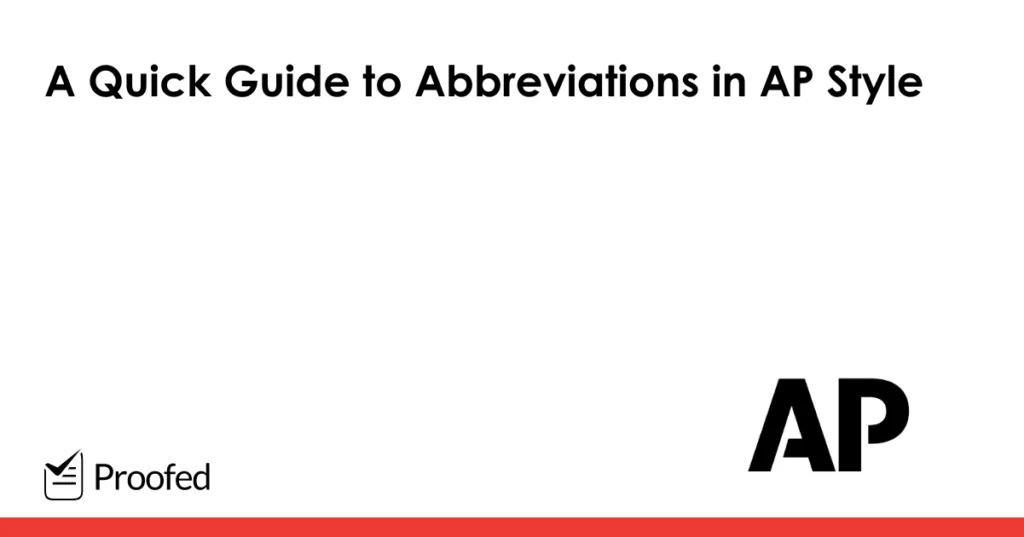The AP Stylebook has a lot of helpful advice about writing clearly and concisely. But what does it say about acronyms and initialisms? Check out our guide to abbreviations in AP style to find out.
Acronyms and Initialisms in AP Style
The overriding concern when it comes to using abbreviations in AP style is clarity. This is why the AP Stylebook recommends only using widely recognized acronyms and initialisms. What constitutes a well-known acronym or initialism, though, will depend on the circumstances.
The AP Stylebook offers some help here, as it features entries on a range of common abbreviations, acronyms, and initialisms. But in general terms, all it says is not to use abbreviations that your readers may not recognize.
As such, when deciding whether to use an abbreviation, think about:
- Whether it is a term your target audience will already know.
- If it could be ambiguous (e.g., abbreviations with two meanings).
For instance, if you were writing for a US audience of broadcasting professionals, you could use the initialism “FCC” with confidence because the readers would know this is the Federal Communications Commission. But if you were writing for a more general audience or international readers, you would be better off using the full name for clarity.
Introducing Abbreviations
Unlike many style guides, AP style says not to introduce abbreviations in brackets alongside the full terminology. If you need to introduce one, instead, you should just use the full terminology without the shortened form, then use the shortened form on the next use:
The Football Association of Ireland (FAI) announced today that it is providing more grassroots support for soccer fans. This new FAI scheme will improve access to youth sport… ✗
The Football Association of Ireland announced today that it is providing more grassroots support for soccer fans. This new FAI scheme will improve access to youth sport… ✓
In addition, the AP simply says “Names not commonly before the public should not be reduced to acronyms solely to save a few words.” As above, then, you should only use an abbreviation if you are confident your readers will recognize it and that it won’t cause any confusion.
Punctuating Abbreviations in AP Style
In terms of punctuation, the AP’s general advice is to use periods between letters in two-letter initialisms, such as “U.S.,” “U.K.,” “U.N.,” “B.C.,” and “A.D.” But this is only necessary for longer abbreviations when the letters in an initialism would spell an unrelated word otherwise.
There are exceptions to the two-letter abbreviation punctuation rule, too:
- Never punctuate initialisms in a headline unless necessary for clarity.
- Some two-letter abbreviations are exempt, including AP, EU, ID and GI.
In addition, punctuating initialisms is less common in British and Australian English. As such, you may want to omit the periods in two-letter abbreviations as well if you’re writing for an audience outside the US.
Abbreviations with Names
When it comes to people’s names, AP style requires you to abbreviate:
- Honorific titles before a name (e.g., Mr. Smith and Ms. Holson).
- “Junior” and “senior” after a name (e.g., George Bush Jr.).
- Academic degrees after a name, set off with commas from surrounding text (e.g., Dr. Samuel Hendrick, Ph.D., announced the results).
It also suggests abbreviating certain words after company names:
- Company (e.g., Austin Motor Co. or P. Morgan Chase & Co.)
- Corporation (e.g., Bantana Corp. or KeySpan Corp.)
- Incorporated (e.g., Proofed Inc. or La-Z-Boy Inc.)
- Limited (e.g., Kenwood Ltd. or Cooper Industries Ltd.)
Generally, you only need to include these company abbreviations when using the full formal name of a company. And even then, you only need to use them once, after which they can be omitted.
Abbreviating Months
AP style suggests abbreviating certain months when using them alongside a day in a date. You can see how this works below:
|
Month |
Abbreviation |
Example |
|
January |
Jan. |
On Jan. 21, 2018, the company announced… |
|
February |
Feb. |
The product was launched on Feb. 3, 2020… |
|
March |
N/A |
The meeting will be held on March 10, 2021… |
|
April |
N/A |
This last occurred on April 21, 1986… |
|
May |
N/A |
The premiere is on May 5, 2021… |
|
June |
N/A |
The scheme began on June 21, 1990…. |
|
July |
N/A |
On July 8, 2008, newspapers reported… |
|
August |
Aug. |
Since Aug. 18, 2019, officials claim… |
|
September |
Sept. |
I first wrote to you on Sept. 7, 1999… |
|
October |
Oct. |
We first met on Oct. 31, 2004… |
|
November |
Nov. |
Born on Nov. 14, 1973… |
|
December |
Dec. |
The event on Dec. 30, 2020, will be… |
But you do not need to abbreviate months when they’re used without a day:
Find this useful?
Subscribe to our newsletter and get writing tips from our editors straight to your inbox.
In January 1989, the world changed.
The town hosts the events annually in April and October.
Make sure to keep this distinction in mind when writing dates AP style!
Avoiding Alphabet Soup
The AP warns against alphabet soup. This occurs when you use several abbreviations in succession, which makes text harder to follow. For instance:
Today, POTUS met with the CO of NATO forces and the CMO of WHO at a UN summit to discuss NAFTA. ✗
If you find yourself using multiple abbreviations in a single sentence, think about using the full terms in at least some cases (or try to rephrase in a way that keeps the abbreviations separate). And if you need any help ensuring your writing is easy to read, don’t forget to have it proofread.



